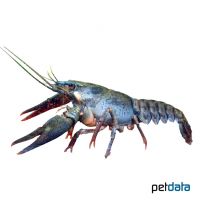Noble Crayfish (Astacus astacus)
| Noble Crayfish Astacus astacus | |
|---|---|
| Name | Noble Crayfish |
| Name Lat. | Astacus astacus |
| Family | Astacid Crayfish |
| Family lat. | Astacidae |
| Order | Decapods |
| Order lat. | Decapoda |
| Origin | Europe |
| Habitat | Streams, ponds |
| Diet | Detritus, leaves, crayfish food |
| pH | 7.0-8.0 |
| Behavior | Nocturnal, aggressive |
| Keeping | Individual, pair |
| Care Level | Easy |
| Reproduction | Oviparous |
| Breeding | Moderately difficult |
| Life Span | 15-20 years |
| Protection | EC FFH Directive Annex V |
| Metric Units | |
| Size | 15-20 cm |
| Temperature | 4-22 °C |
| Hardness | 10-20 °dH |
| Aquarium | ~ 200 l or pond |
| US Units | |
| Size | 6"-8" |
| Temperature | 39-72 °F |
| Hardness | 178-356 ppm |
| Aquarium | ~ 50 gal or pond |
Distribution and habitat
European crayfish are distributed throughout Europe, except for the Iberian Peninsula, Ireland and northern England. They live in stagnant and flowing waters, such as streams, rivers, oxbow lakes, lakes and ponds, where they hide during the day in bank cavities, under stones and roots.
Maintenance
When caring for them in a cold water aquarium, be sure to provide plenty of hiding places (crab burrows, roots) and plenty of free, burrowable bottom areas of sand and gravel covered with fallen leaves.
Pond keeping is possible all year round. The pond should be furnished with pond, floating and oxygenating underwater plants (water milfoil, water plant, hornwort, etc.), large river pebbles and a graveable substrate of round-grained gravel and sand
No ammonia, ammonium and nitrite should be detectable in the water and the nitrate value should be below 50 mg/l. When using a filter, make sure that only a weak current is created.
Diet
They are omnivores that feed in nature on detritus, fallen leaves, snails, mussels and dead fish. For a balanced diet, feed once a day with dry food for crayfish (tablets, granules, pellets, sticks) as well as mosquito larvae, artemia, mysis or earthworms (live or frozen). In addition, they need vegetable food, such as scalded leafy and wild vegetables, carrots, peas or aquatic plants, as well as fallen leaves (beech, poplar, oak, walnut, etc.).
Unaccepted food must be removed after 2-3 hours. Regular and varied feeding promotes health and prevents deficiency symptoms
Behaviour and compatibility
They are solitary outside the mating season and behave aggressively within the species, but also towards other crayfish. Keeping several pairs or groups is only recommended in a much larger and richly structured tank. A socialization with not too small fish is well possible. In principle, only compatible animals with similar demands on water quality and water temperature may be socialized.
Reproduction and breeding
In the much larger males, the last two pairs of swimming legs are developed into mating organs (gonopods). Mating takes place when water temperatures drop (about 10 °C) in late autumn. During mating, the male turns the female on her back or side and transfers a sperm package with his gonopods. The female carries the eggs (70-250 pieces) on her pleopods (webbed feet) until the young hatch after 8 to 9 months in early summer
Species protection
Protection of species: EU Habitats Directive Annex V. The proof of purchase is the required proof of origin for the animal. Please keep it safe! Your pet store will be happy to provide you with further information.
Important
They can be kept all year round in the garden pond with a minimum water depth of 1 m.
The foliage (e.g. oak) is not only food, but also serves to prevent and fight diseases. Too high temperatures accelerate growth and shorten life expectancy.
The European crayfish (noble crayfish), now extinct in many parts of Europe, was widespread in Europe until the advent of crayfish plague at the end of the 19th century
The well-being of the fish must be checked regularly. A regular partial water change, according to the aquarium or pond size is recommended, even if the pollutant load has not yet reached the upper limit. Sudden changes in water quality should be avoided. Newly introduced animals must be accustomed slowly to the water in the aquarium or pond
Further literature can be found in your pet store.
References
Text: petdata; Image: petdata
Source: LUKHAUP & PEKNY (2008): Süßwasserkrebse aus aller Welt, Dähne Verlag; ENGELMANN & LANGE (2011): Zootierhaltung - Tiere in menschlicher Obhut: Wirbellose, Verlag Harri Deutsch
